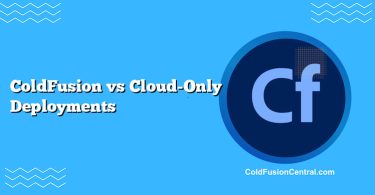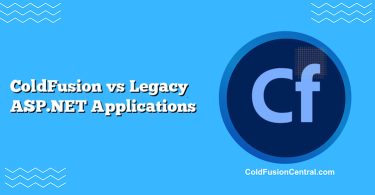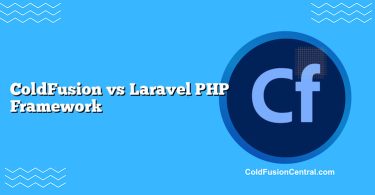Definitions
-
ColdFusion: A commercial, JVM-based application server and scripting language (CFML) by Adobe, designed for rapid web development. It includes built-in features for database access, caching, PDF generation, email, and simplified creation of REST APIs. An open-source alternative, Lucee, also runs CFML on the JVM.
-
Custom-Built APIs: APIs developed from scratch using general-purpose frameworks and languages such as Node.js/Express, Java/Spring Boot, .NET (ASP.NET Core), Go (Gin/Fiber), Python (FastAPI/Django), or serverless platforms (AWS Lambda, Azure Functions). These are assembled from modular libraries and services to meet specific requirements.
Overview
What is ColdFusion?
ColdFusion is both a platform and language (CFML) focused on developer productivity, particularly for data-driven web apps and administrative back-office tools. It offers a full-stack runtime with many batteries included: ORM (via Hibernate), task scheduling, caching, PDF/reporting, mail services, and out-of-the-box REST endpoints. ColdFusion shines when teams want to quickly expose data and workflows without stitching together multiple libraries.
ColdFusion can run on Windows, Linux, and containerized environments. Licensing is commercial for Adobe ColdFusion, while Lucee is an open-source CFML engine.
What are Custom-Built APIs?
Custom-built APIs refer to services constructed using general-purpose ecosystems like Java Spring Boot, ASP.NET Core, Node.js/Express, Go, or Python FastAPI. Teams choose their stack based on performance, language familiarity, cloud strategy, and integration requirements. This approach offers maximum flexibility: microservices architecture, Kubernetes orchestration, polyglot services, and integration with modern API gateways (Kong, Apigee, AWS API Gateway, Azure API Management).
Key Features
ColdFusion (Adobe CF/Lucee)
- Built-in REST support with cfcomponent and restPath annotations.
- CFML tags and script syntax for rapid CRUD endpoints.
- Built-in ORM, caching, PDF, email, scheduled tasks, and image manipulation.
- Integrated security features like session management, password hashing functions, CSRF protection utilities.
- Out-of-the-box admin console for datasource, caching, and service configuration.
- Support for JVM tuning, deployment on Tomcat/JEE, and use of Java libraries.
Custom-Built APIs
- Choice of frameworks: Spring Boot, ASP.NET Core, Express/Koa/Fastify, FastAPI, Go frameworks.
- First-class microservices support with Docker and Kubernetes.
- Advanced observability (OpenTelemetry, Prometheus, Grafana, ELK).
- Deep ecosystem for authentication and authorization (OAuth2, OpenID Connect, JWT).
- Seamless integration with cloud-native services: serverless functions, managed databases, event buses (Kafka, SQS), and cache layers (Redis, Memcached).
- Advanced API patterns: GraphQL, gRPC, CQRS/Event Sourcing.
Performance
ColdFusion
- Runs on the JVM; performance is competitive for typical CRUD/API workloads when properly tuned (JVM heap, GC, query caching).
- Built-in caching and ORM can reduce latency but introduce complexity if misconfigured.
- For CPU-bound workloads or ultra-low-latency, ColdFusion generally trails Go or highly optimized .NET/Java microservices.
- Works well for moderate-throughput enterprise APIs and intranet portals.
Custom-Built APIs
- Go and optimized .NET often deliver the best raw throughput and lowest latency.
- Node.js excels in I/O-bound scenarios with huge concurrency; CPU-bound tasks may need worker threads or offloading.
- Java/Spring Boot can match high-performance needs with proper tuning and non-blocking I/O (WebFlux).
- Serverless functions scale concurrency automatically but can incur cold start penalties if not kept warm.
Scalability
-
ColdFusion:
- Scales vertically by adding CPU/RAM to the JVM and horizontally via multiple instances behind a load balancer.
- Supports session storage options (database, Redis via extensions) to enable stateless scaling.
- Less commonly deployed as dozens of microservices; more typical in monolith or a small set of services.
-
Custom-Built APIs:
- Designed for horizontal scaling and microservices. Works naturally with service meshes (Istio/Linkerd).
- Easy to implement autoscaling policies in Kubernetes; supports fine-grained scaling per service.
- Decentralized design allows teams to scale hot endpoints independently.
Security
-
ColdFusion:
- Built-in functions for input encoding, hashing, and token generation.
- Can implement CSRF protection, TLS, and integration with SSO (SAML/OIDC) using third-party libs.
- Adobe releases regular security hotfixes; follow OWASP guidelines and WAF best practices.
- Attack surface can increase if admin console is exposed; harden configuration and restrict access.
-
Custom-Built APIs:
- Rich ecosystem for OAuth2, JWT, mTLS, and API gateways (rate limiting, IP allowlists, request validation, threat detection).
- Greater control over OWASP Top 10 mitigations, secret management (Vault/Parameter Store), and zero trust patterns.
- Requires disciplined configuration since security depends on library choices and proper implementations.
Cost
-
ColdFusion:
- Adobe ColdFusion licensing is commercial and can be significant for large deployments.
- Lucee provides an open-source alternative, reducing licensing costs while retaining most CFML features.
- Faster development can translate to lower engineering costs for simple-to-moderate APIs.
-
Custom-Built APIs:
- No platform licensing; you pay for infrastructure, managed services, and developer time.
- Potentially higher initial development cost but can be optimized with container orchestration and serverless pay-per-use.
- Easier to hire engineers familiar with mainstream stacks, lowering long-term staffing costs.
Community Support and Ecosystem
-
ColdFusion:
- Smaller community; strong presence in legacy enterprise environments and government.
- Adobe support for licensed customers; active Lucee community and CFML Slack/Discord groups.
- Fewer modern libraries compared to mainstream stacks.
-
Custom-Built APIs:
- Vast and active communities for Java, .NET, Node.js, Python, Go.
- Frequent updates, large plugin markets, abundant tutorials, and Stack Overflow activity.
- Rich ecosystem of DevOps and cloud-native integrations.
Developer Experience and Tooling
-
ColdFusion:
- CFML is easy to learn; rapid prototyping with minimal boilerplate.
- Admin UI simplifies datasource, mail, and caching setup.
- IDE support via VS Code extensions, IntelliJ plugins, or Adobe CF Builder.
-
Custom-Built APIs:
- More setup choices mean more flexibility and complexity.
- Excellent tooling: VS Code, IntelliJ/Rider, powerful debuggers, test frameworks (JUnit, xUnit, Jest), and CI/CD templates.
- Strong OpenAPI/Swagger toolchains and code generators.
Real-World Use Cases
When ColdFusion is preferred
- A medium-sized enterprise needs to expose existing CFML business logic as REST endpoints to integrate with a new front-end.
- Requirements include rapid delivery, moderate concurrency, scheduled jobs, and built-in PDF/report generation.
- The team already maintains Adobe CF or Lucee servers and wants to leverage existing investments.
Example scenario: A government agency with a decade-old ColdFusion portal needs mobile app access. They wrap domain operations with REST via cfcomponent/cffunction, add Redis-backed caching, and secure endpoints with token-based auth. Delivery is fast because the data access and validations already exist in CFML.
When Custom-Built APIs are preferred
- A startup building a microservices platform at scale with Kubernetes, event-driven architecture (Kafka), and polyglot services.
- Strict latency targets, complex auth requirements (OAuth2 + fine-grained scopes), and global deployment with multi-region failover.
- The organization prioritizes cloud-native patterns, distributed tracing, and CI/CD with canary releases.
Example scenario: A fintech platform builds transaction services with Go for speed, account services with Java/Spring Boot for robustness, and uses Kong + OPA for policy enforcement. Observability uses Prometheus + Grafana with OpenTelemetry traces, scaling to thousands of RPS per service.
Implementation Snapshot (Step-by-Step)
ColdFusion REST endpoint (conceptual steps)
- Define a CFML component with rest-enabled annotations (e.g., restPath, httpmethod).
- Configure REST application in the ColdFusion Administrator (or Application.cfc).
- Bind a datasource in the Admin UI; use ORM or cfquery for data access.
- Add authentication (token header) and validate input (EncodeForJSON/HTML, ESAPI-style).
- Apply caching and rate limiting via server configs and web server/proxy (e.g., NGINX).
Custom-built API (e.g., Node.js + Express steps)
- Initialize project and install dependencies (express, helmet, joi/zod for validation).
- Define routes and controllers; integrate with DB via ORM/Query builder (Prisma/TypeORM/Knex).
- Secure endpoints with OAuth2/JWT using Passport or Auth0 SDK.
- Add middleware for rate limiting, CORS, and logging (morgan/pino).
- Containerize with Docker; deploy to Kubernetes; add HPA, Prometheus metrics, and centralized logging.
Supported Platforms and Deployment
-
ColdFusion:
- Platforms: Windows, Linux, container images (Tomcat-based), JEE servers.
- Deployment: Traditional VMs, on-prem, containers; possible Helm charts from community.
- Alternatives: Lucee CFML engine for open-source deployments.
-
Custom-Built APIs:
- Platforms: Cross-platform via Docker/Kubernetes; serverless on AWS Lambda, Azure Functions, Google Cloud Functions.
- Deployment: CI/CD pipelines to cloud providers; service mesh support; blue/green or canary.
- Gateways: Kong, Apigee, AWS API Gateway, Azure API Management.
Side-by-Side Comparison Table
| Dimension | ColdFusion (Adobe CF/Lucee) | Custom-Built APIs (Java/.NET/Node/Go/Python) |
|---|---|---|
| Performance | Good for typical CRUD; JVM tuned performance; not top-tier for ultra-low latency | Excellent with right stack; Go/.NET/Java can achieve very high throughput |
| Scalability | Vertical + horizontal scaling; often monolithic or small set of services | Horizontal scaling with microservices; fine-grained autoscaling |
| Security | Built-in utilities; rely on proper configuration and patching | Rich ecosystem; OAuth2/JWT, gateways, zero-trust patterns |
| Cost | Adobe license (paid) or Lucee (free); lower engineering time for simple apps | No license fees; potentially higher initial dev cost; broad hiring pool |
| Ecosystem | Smaller; strong legacy/enterprise presence | Vast libraries, tools, cloud-native integrations |
| Use Cases | Rapidly exposing existing CFML logic, intranet apps, reporting-heavy APIs | Cloud-native platforms, high-scale public APIs, microservices architectures |
| Pros | Rapid development, batteries-included, simple admin | Flexibility, performance options, modern DevOps, strong community |
| Cons | Licensing (Adobe), smaller community, less microservices-native | More setup complexity, must select/maintain many components |
Pros and Cons
ColdFusion
Pros:
- Rapid development with CFML and admin UI.
- Batteries-included: ORM, caching, PDF, mail, scheduling.
- Easy to expose REST endpoints and integrate with databases.
- Option of Lucee for cost-effective, open-source deployments.
Cons:
- Adobe licensing cost (unless using Lucee).
- Smaller community and fewer modern libraries.
- Less aligned with microservices by default; requires additional tooling to match cloud-native patterns.
Custom-Built APIs
Pros:
- Flexibility to choose the best language/framework for each service.
- Top-tier performance options (Go/.NET/Java).
- Designed for microservices, containers, and cloud-native operations.
- Strong security, API gateway options, and observability tooling.
Cons:
- More moving parts; increased complexity and decisions.
- Longer initial setup and higher maintenance burden.
- Requires stronger DevOps maturity for reliability and scaling.
Decision Factors / Which One Should You Choose?
-
Choose ColdFusion if:
- You already run Adobe CF or Lucee and want to reuse CFML code.
- You need to deliver a data-driven API quickly with built-in features like reporting and scheduling.
- Your throughput requirements are moderate and you prefer a single cohesive platform.
-
Choose Custom-Built APIs if:
- You target microservices, Kubernetes, and multi-language teams.
- You need maximum performance, flexible scaling, and modern OAuth2/JWT patterns.
- Your organization values cloud-native CI/CD, observability, and vendor-neutral stacks.
-
Balanced approach:
- Use ColdFusion to wrap legacy and domain workflows while building new, high-scale services in Java/.NET/Go.
- Place an API gateway in front for security policies, rate limiting, and analytics.
- Migrate incrementally: carve out high-traffic endpoints into microservices while keeping stable modules in CFML.
Key Takeaways
- ColdFusion offers a fast path to functional REST APIs, especially when you already have CFML assets and want a cohesive, batteries-included environment.
- Custom-built APIs provide unmatched flexibility, performance, and cloud-native scalability—but demand more architectural decisions and DevOps maturity.
- Consider performance targets, team skills, cost constraints, and cloud strategy before choosing.
- A hybrid strategy can unlock quick wins now while paving a path to microservices where it matters.
FAQ
Is ColdFusion still viable for new API projects?
Yes—especially in organizations that already rely on CFML or need fast delivery with built-in features. For greenfield, cloud-native platforms aiming at microservices and extreme scalability, mainstream stacks may offer more long-term flexibility.
Can I run ColdFusion in containers and Kubernetes?
Yes. Both Adobe ColdFusion and Lucee can run in Docker containers and be orchestrated by Kubernetes. You’ll still want externalized configuration, centralized logging, health checks, and readiness probes for production.
How do I secure APIs with OAuth2 or JWT in both approaches?
- ColdFusion: Integrate with libraries or an external identity provider (Auth0, Azure AD, Keycloak). Validate JWTs server-side and manage scopes/roles.
- Custom-built: Use mature middleware and libraries for OAuth2/JWT across frameworks; offload policy and rate limiting to an API gateway.
What about serverless—should I go that route?
Serverless (AWS Lambda, Azure Functions) is great for bursty workloads and pay-per-use economics. It fits custom-built APIs well and can be used alongside ColdFusion by exposing CF services behind a gateway while using functions for event-driven tasks.
Is Lucee a drop-in replacement for Adobe ColdFusion?
Lucee is largely compatible with CFML and offers strong performance with no license cost. Some Adobe-specific features or enterprise connectors may differ; test critical features and libraries before migration.




